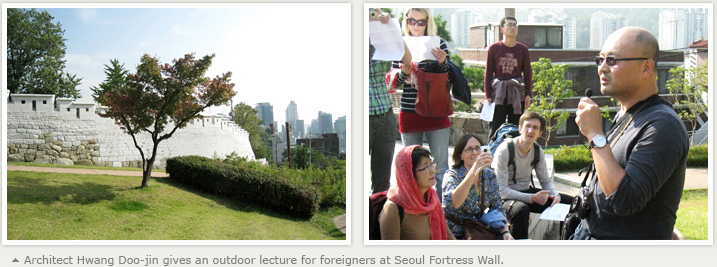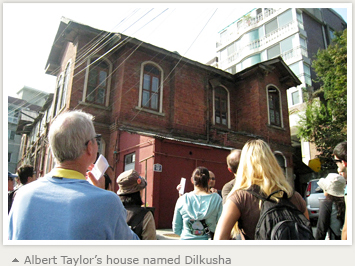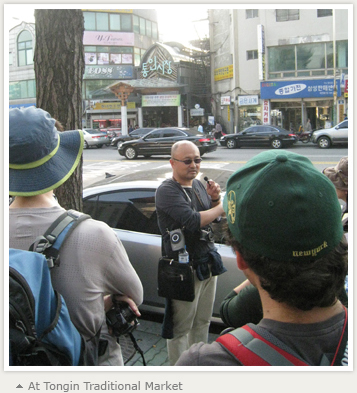"In the field of architecture, insisting on keeping the unique style of a country can serve to lock up architectural ideas within a framework of the past. We should move on toward more practical and creative architecture, which can make hanok (traditional Korean house) a visual icon."
For an outdoor session of the Korea Foundation's English Lecture Series on Korea Culture for Foreigners, the architect Hwang Doo-jin gave a lecture tour on the theme of ''Winding through Seoul: The Fortress Walls of Seoul and Seochon." Hwang is a prominent architect who is known for having a strong affection for hanok as well as being one of its most outspoken critics. For this reason, whenever he is referred to as a "hanok architect," the quotation marks seem to be quite appropriate.
Hwang strongly rejects the concepts of hanok that are confined within the narrow framework of people's perceptions. He expresses serious concern about people who regard hanok as only a cultural property, in which case the sustainable development of its architectural style will not be possible. Therefore, Hwang believes that you must consider the lives of hanok residents, both in time and space, along with the modernity of the current era. Moreover, he warns that only when creative ideas are freely applied to architecture can houses fully accommodate the reality of our dynamically changing lives.

Throughout history, no particular community has achieved development with its life and knowledge being confined to a specific category. So, what an architect should attempt is to graft a spirit of silsagusi (seeking truth from facts) onto architecture. Spurring and encouraging our housing styles to undergo creative dismantlement and evolution, instead of limiting it to the existing framework of hanok, so that the dynamism of architecture can be developed in a dialectical manner, is the proper direction for the development of Korean architecture, he explains. Insisting only on the past style, without considering the practical needs of today's people is certainly not a desirable approach for an architect.
For example, Bilbao, a city in northern Spain, is frequently cited as a new model for urban architecture in the 21st century. Since the late 1990s, Bilbao has undergone a complete transformation into a cultural city after the completion of its new Guggenheim Museum. The emergence of this city as a ''cultural masterpiece" is a result of the creative imagination of Bilbao residents, who sought to move beyond the city's tradition of smokestack industries. And today, Bilbao is known as a cultural city thanks to its all-new architectural paradigm that emphasizes the modernity of Spain and its people.
Then, what is situation in Seoul, the capital of Korea that is half a world away from Bilbao? Can Seoul really learn from the experience of Bilbao and its similar historical background and adopt an alternative approach for its own urban architecture?
 Hwang is regarded as one of the few architects in Korea who strives to apply a Bilbao-type alternative in Seoul. In an interview, he made note: ''Tradition doesn't exist continually as itself, nor should it. The same is true for hanok. As long as you confine hanok within the concept, which was used to portray the original architectural style when Western culture was first introduced to Korea, you can't expect to see the further development of hanok architecture. Actually, the concept of hanok itself has only a 100-year-or-so history."
Hwang is regarded as one of the few architects in Korea who strives to apply a Bilbao-type alternative in Seoul. In an interview, he made note: ''Tradition doesn't exist continually as itself, nor should it. The same is true for hanok. As long as you confine hanok within the concept, which was used to portray the original architectural style when Western culture was first introduced to Korea, you can't expect to see the further development of hanok architecture. Actually, the concept of hanok itself has only a 100-year-or-so history."
Hwang says that we shouldn't allow the tradition of hanok to remain in the ''not-so-long-ago," past. As a matter of fact, Bukchon Hanok Village, which is widely known as a traditional hanok district, is nothing but a neighborhood of commercial buildings d by Seoul businessmen in the 1930s. It is a modernized hanok development hurriedly d when the construction business was enjoying a boom due to a surge in demand after the Manchurian Incident in the 1930s.
According to Balter Benjamin, who is aligned with Hwang's architectural sensibilities, when times change, so do people's perceptions and sense of beauty. This is because art and architecture are social products. Artworks of the past also reflect the aesthetic sentiments of that society, which differ from that of our modern times. Therefore, we should focus on the impact of a new form of intellectualism, which can be brought about through revolutionary change.
Hwang has always emphasized that images of new civilizations and people's lives should be captured in a positively developed architectural style. The housing styles for people, which are suited to the local conditions and climate, should always be the goal of an architect's efforts.
For a while, Hwang said, he felt pressure due to the public's excessive interest in traditional hanok, but he recently came up with an innovative concept to catch two rabbits at one time: the effective use of land and a housing concept for''working and living at one place,"This is not a monotonous architecture with a similar appearance but an architectural style for having a compact garden and yard area on the rooftop and bringing together separate housing, commercial, and business uses into one building. This way, you don't have to waste time to get to and from work, and can realize eco-friendly architecture with a healthy balance. This is what he calls a ''rainbow rice cake building.”
''Hanok architecture stands at a crossroads today. You can properly realize an innovative modernism only when it is combined with a different kind of culture. What's wrong with using wood, steel frame, and concrete materials for a four- or five-story building? Through this type of architecture, we can a more sound and healthy housing and work environment for Seoul, while eliminating thoughtless urban development. We can also develop this into a major housing type after national unification."
 The current architectural style, which relies on a ''doughnut phenomenon" is simply not sustainable. Thus, Hwang suggests a ''rainbow rice cake" housing style, which is capable of accommodating permanent and transient populations, as a desirable alternative. In 2002, he surprised other architects based in Gangnam, southern Seoul, by relocating his living and working space to Seochon, in Tongui-dong, northern Seoul. One government official said jokingly: UI have seen many architects moving out of Gangbuk (northern Seoul), but Hwang was the first architect to move into Gangbuk."
The current architectural style, which relies on a ''doughnut phenomenon" is simply not sustainable. Thus, Hwang suggests a ''rainbow rice cake" housing style, which is capable of accommodating permanent and transient populations, as a desirable alternative. In 2002, he surprised other architects based in Gangnam, southern Seoul, by relocating his living and working space to Seochon, in Tongui-dong, northern Seoul. One government official said jokingly: UI have seen many architects moving out of Gangbuk (northern Seoul), but Hwang was the first architect to move into Gangbuk."
The current architectural style, which relies on a ''doughnut phenomenon" is simply not sustainable. Thus, Hwang suggests a ''rainbow rice cake" housing style, which is capable of accommodating permanent and transient populations, as a desirable alternative. In 2002, he surprised other architects based in Gangnam, southern Seoul, by relocating his living and working space to Seochon, in Tongui-dong, northern Seoul. One government official said jokingly: UI have seen many architects moving out of Gangbuk (northern Seoul), but Hwang was the first architect to move into Gangbuk."
These days, Hwang calls himself a ''neighborhood architect," He continues with the efforts to graft modernity onto the living environment.
His masterpieces include the company building of publishing house Open Books, Hainaim Publishing House office in Donggyo-dong, Mumuheon hanok and restaurant Gahoeheon in Bukchon, and Gallery Artside in Tongui-dong. His respect for neighborhood buildings is well demonstrated in the lofty gate of Tongin Conventional Market.
"Hanok should focus on the process and attitude rather than on the result. The Byeongsan Seowon (Confucian academy) and Muryangsujeon Hall of Buseoksa Temple are only subjects of inspiration for architects and they should be the catalyst for creative revolution," he emphasized. For Hwang Doo-jin, hanok remains a personal pursuit. For him, it is not a cultural property but a means to promote modernism and contemporary architecture.
Kim Hyeong-bai
Adjunct Professor of Journalism and Mass Communication
Hanyang University
 한국국제교류재단
한국국제교류재단












